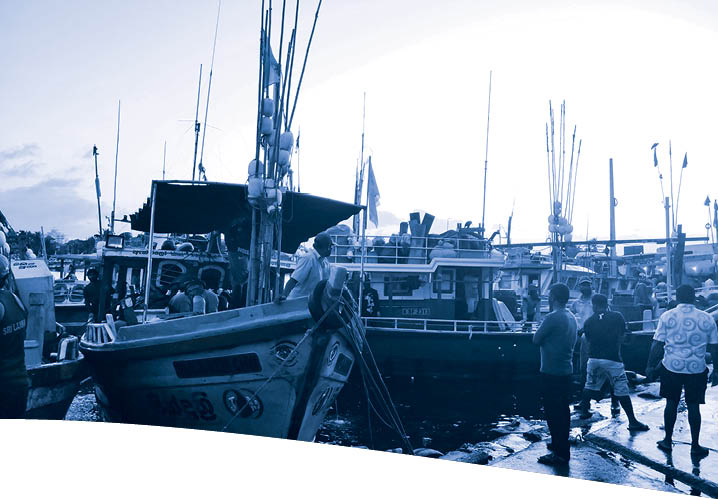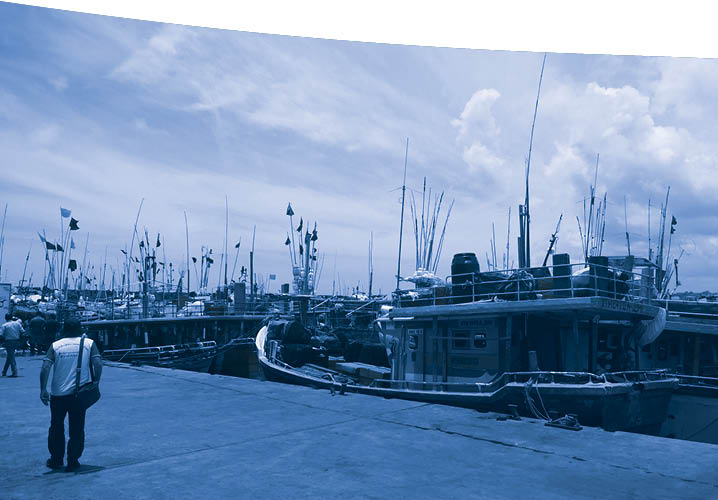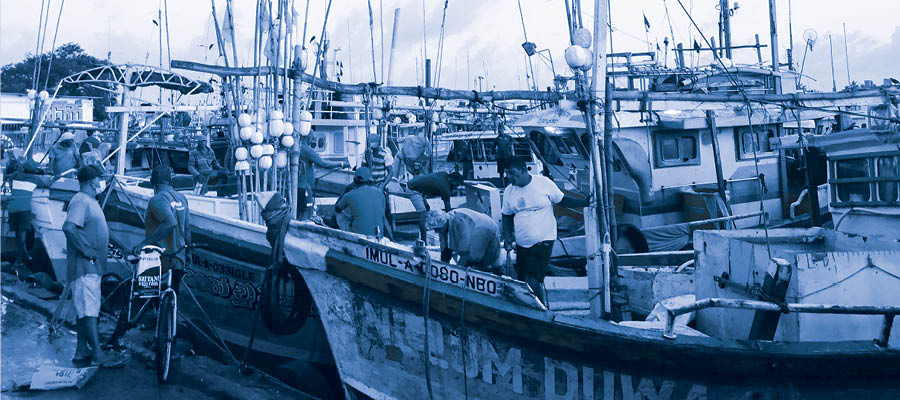Multidimensional solutions strategy for the reduction of food loss and waste in the multiday fisheries subsector in Sri Lanka
This multidimensional solutions strategy for reducing the losses is a comprehensive, multisectoral approach aimed at addressing the challenges and maximizing the potential of the multiday fisheries subsector in Sri Lanka. It strives to tackle the significant losses with a strong emphasis on promoting the responsible use of fisheries resources for sustainable development. The strategy’s design is based on the robust foundation of assessment findings, extensive engagement of stakeholders, and a thorough understanding of the underlying causes and impacts of food loss and waste (FLW).
Strengths, weaknesses, opportunities and threats

- regulatory framework under review: refiling of new Fisheries Act and crafted ice production, dried fish and canning regulations;
- codes of practice to promote improved practices;
- ongoing research projects related to food loss and waste (FLW) solutions (longlining to prevent predator attacks, improved onboard refrigeration systems);
- fishery education programmes and facilities (e.g. skippers training programme);
- established institutions under the Ministry of Fisheries (MoF), such as the Department of Fisheries and Aquatic Resources (DFAR), National Aquatic Resources Research and Development Agency (NARA), Ceylon Fishery Harbours Corporation (CFHC), National Aquaculture Development Authority of Sri Lanka (NAQDA), CeyNor Foundation, NORTHSEA – 148 fishery inspector divisions, high seas fisheries units under DFAR that could provide extension services;
- cold chain concept established;
- examples of improved fish handling and processing practices, especially in the export supply chain, which meet international standards; and
- physical loss of fish relatively small and mainly at pre-harvest stage.

- significant quality loss in fish landings (43 percent) – causes include long trip duration, problems with ice, onboard storage practices and equipment, unloading practices;
- lack of options in terms of alternative technologies that could reduce FLW and the benefits of these technologies;
- vessel design and equipment (low uptake of winches, line setters, fish finders, storage, energy use);
- lack of application of good fish handling practices and alternative technologies among fishers, processors, wholesalers, retailers and transporters supplying domestic market;
- outdated or substandard onshore facilities and services (water supplies, waste disposal, ice plants, cold rooms, and waste treatment plants, harbours, markets);
- high production costs compared to other countries, making it difficult to compete with international markets;
- challenging to access to investment and loans for upgrading vessels and
- onshore facilities;
- lack of awareness among consumers of fish quality issues and appreciation of quality in the domestic supply chain;
- lack of data and deficiencies in systems for data collection and monitoring domestic fish market channels; and
- implementation of (food safety and quality) regulation particularly for domestic supply chain and lack of regulation of ice manufacturing.
- use of social media for training and raising awareness on harvesting (Facebook, TikTok, YouTube, WhatsApp, etc.);
- appropriate and improved fishing, post-harvest and energy-saving technologies for increased efficiency and post-harvest loss reduction (vessel design, equipment, cold chain, renewable and hybrid energy, digital marketing);
- mother vessel system with traceability (concept note exists);
- strong demand for fish on international market (new international trade agreements with other countries, Sri Lanka brand);
- support from international development organizations and research groups; and
- membership of international agreements such as the Indian Ocean Tuna Commission (IOTC).
- high cost of energy effecting all aspects of supply chain (fishing, ice, transport);
- climate change;
- competition for fishery resources on high seas and illegal, unreported and unregulated fishing (IUU);
- depreciation of the Sri Lanka rupee; and
- prohibition of subsidies under Sustainable Development Goal 14.

Vision
By 2033, the quality loss in the multiday fishery of Sri Lanka will be reducedby 30 percent through:
- the implementation of policies and introduction of improved new technology;
- a strengthened regulatory framework;
- enhanced skills, knowledge, systems and practices; and
- the development of infrastructure.
This will contribute to an improved domestic and export sector, and ultimately to the national economy, food security and nutrition.Sri Lanka will be a leading country in South Asia in fish loss and waste reduction.
Specific objectives

Outputs and outcomes
Outputs | Outcomes |
· Plan for fleet modernization · Modernized multiday vessel design agreed upon by stakeholders · Good onboard fish handling and hygiene capacity-building programme including technology recommendations and knowledge-sharing mechanisms · Financial and technical support guidelines for investment to upgrade multiday fleet · Updated regulatory framework for multiday vessels | Boat owners, skippers and fishers apply improved technology and better practices |
· Market research: improved understanding of domestic market opportunities for fish and consumer demand and behaviour · Implemented multi-institutional fish quality awareness-raising campaign to provide information to consumers · Fish recipes made available (e.g. fish-related food festival) – promotion of value addition · Improved accessibility to quality fish through appropriate mechanism (online, community fishery centre) · Updated food safety regulatory framework | Consumers demand better quality fish |
· Assessment of ice manufacturing sector · Updated regulatory framework for ice manufacturers · Upgraded ice plant facilities, as well as increased ice production capacity and application of energy-efficient technology · Ice manufacturers apply good hygiene practices (GHP) and good manufacturing practices (GMP) · Guidelines for usage of ice by users | Ice producers supply better quality ice |
· Harmonization of regulatory framework (including roles and responsibilities) · Capacity-building programme for government stakeholders undertaken · Resource mobilization (equipment) to aid implementation · New technology introduced to inspect and record fish quality · Proper mechanism established for monitoring the work of authorized officials | Regulatory bodies and government are better able to implement legislation |
· National distribution strategy developed · Guidelines on best practices (including GHP, handling practices and use of ice, maintaining the cold chain) and capacity-building programmes · Infrastructure development · Energy efficient cold chain and other technology for transport, processing and sales pilot-tested and available · Fish transporters association established and empowered · Financial and technical support guidelines for investment to upgrade activities · National fish traders association established and empowered | Supply chain actors (transporters, wholesalers, retailers) improve handling practices |
· Market research study · Capacity-building programme in GMP, GHP, fish handling, processing practices, value addition and market opportunities · Food safety and fish processing regulatory framework harmonized and updated · Quality-based Sri Lankan brands promoted · Updated market information platform · Establishment of digital platform for fisheries value chain | Processors and buyers supplying the domestic market demand better quality fish |
· Capacity building for local governments (LGs) and authorities in fish loss and waste solutions · Politically endorsed institutional arrangement and memorandum of understanding (MOU) over fish loss and waste solutions regarding delegation and collaboration between national and local authorities · Allocated funds for investments in infrastructure (few LGs are self-sufficient) · Provision of new, cost-effective technologies – including renewable energy solutions – which transform processes like waste disposal and water supply into profitable operations · Introduction of effective rewarding system for LGs on reduced FLW | Local (government) authorities are empowered to invest in and apply fish loss and waste solutions |
· Established and continued national research strategy on fish loss and waste solutions · Improved collaboration with local and international research institutes, academia and the private sector · Strengthened extension services on fish loss and waste solutions · Reduced fish loss and waste due to adaption by grassroots organizations | Research organizations disseminate and raise awareness of results among grassroots organizations |
Conclusion
This multidimensional solutions strategy was validated and endorsed by the FLW Working Group and the Government of Sri Lanka. It is being implemented by different relevant stakeholders through the leadership of the Ministry of Fisheries. Applying this strategy should enhance the efficiency, resilience and profitability of the multiday fisheries subsector while minimizing environmental impacts and ensuring food security. It can be used to attract further investment to complete all of the activities and outputs proposed.






